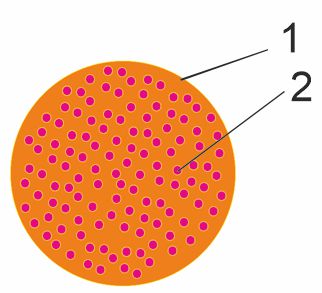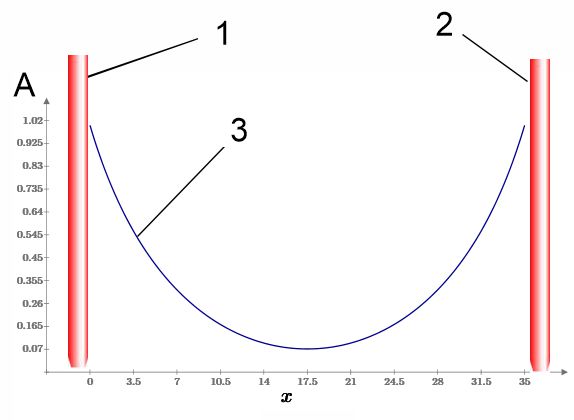Alexandr A.Shpilman ( alexandrshpilman78@gmail.com )
How
does electric current flow in a conductor?
It is well known, but not advertised,
that a direct electric current in a conductor does not flow in a continuous
stream. If we try to show what it looks like in the cross section of conductor 1,
we will have many УjetsФ 2 of current of electric charges in the
conductor.

Why this is so, no explanation is
given.
Let's consider a picture of the
magnitude of the magnetic vector potential A (3) between two long, parallel
electrical conductors 1 and 2 with an electric current flowing
through them in one direction.

The magnitude of the magnetic vector
potential 3 is equal to:
|
|
A(x) ~ j* (1+ln(a/(a+x))
+ ln(b/(b-x))) |
(1) |
|
where |
j Ц the magnitude of the electric current in
the УjetФ |
Formulas from quantum mechanics:
|
|
P(x)=P0-SQRT(q*U(x)*m)Ц q *A(x) |
(2) |
|
where |
P0 Ц initial
electron momentum; |
Change in the impulse of an electric charge carrier in
a УjetФ of electric current:
|
|
p(x) ~ Ц q*A(x) |
(3) |
Change in the speed of
an electric charge carrier in a УjetФ of electric current:
|
|
v(x) ~ Ц q*A(x)/m |
(4) |
Those. the speed of electric charges
in the УjetФ decreases. For electric charges moving in the vector potential, an
electric field also appears:
|
|
E(x) ~ Ц grad(A(x)) |
(5) |
Which will pull free electric charges
in the conductor into the resulting УjetsФ of electric current. Until this
field exceeds the electric field from an increase in the charge density in the
УjetФ.
It must be assumed that this kind of
instability in the flow of electric current will manifest itself in both
superconductors and electrolytes.
Ќо подобное возможно только в сверхпроводниках, но при этом уже начнут про€вл€тьс€ квантовые эффекты. ¬ обычных проводниках ситуаци€ друга€. ¬спомним закон ќма:
|
|
U = R * I |
(6) |
|
where |
U Ц
conductor voltage drop, |
In our case, the following condition
must be met:
|
|
jp/σ = Ei |
(7) |
|
where |
jp Ц current density in the
"jet", |
It is worth considering that here σ is precisely the local specific
electrical conductivity of the electric current conductor, which will be
greater than the value for the material of the electric conductor recorded in
reference books. Since the latter is already integral over the full
cross-section of the conductor, taking into account areas with minimal flow of
electric current.
It is worth
recalling that free electric charges in metals are not free in reality. See Foucault currents. So in
reality the situation is more complex and the figures often given in articles
for the speed of flow of electric charges in a conductor are incorrect.